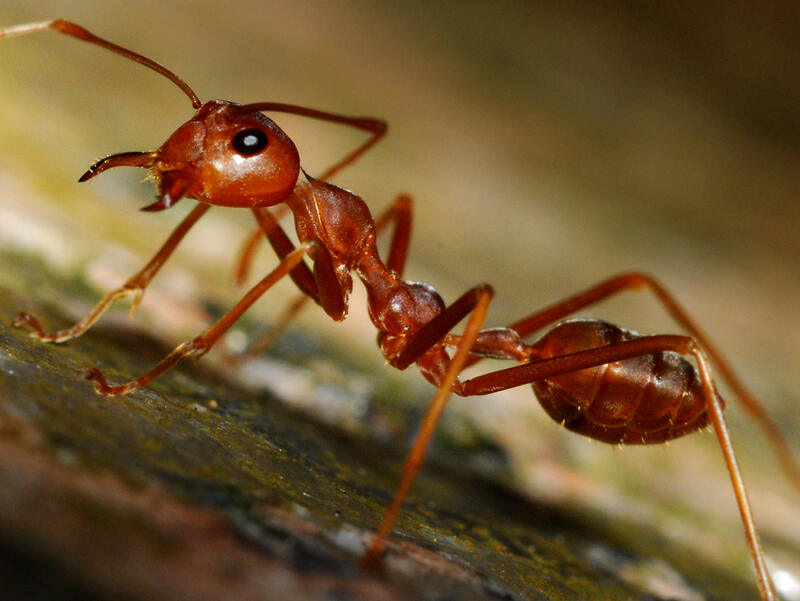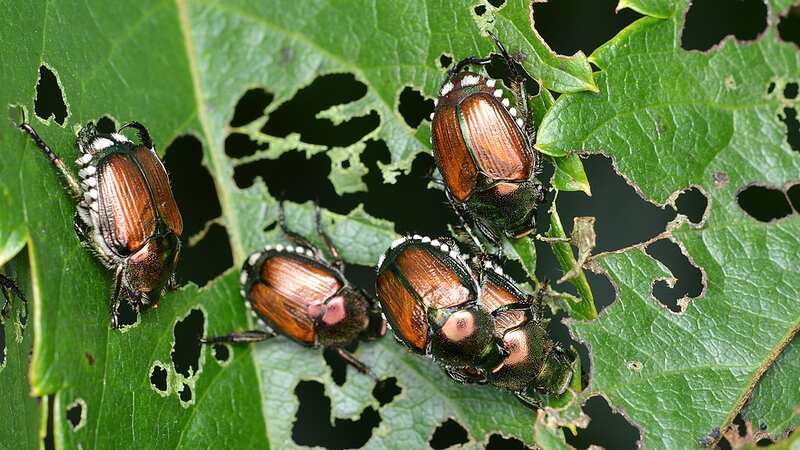
When you look out your lawn, you might not realize it’s a battleground. The fight is against 15 common insect pests damaging your lawn, including grubs, chinch bugs, and armyworms. These tiny invaders can become a huge nuisance if not managed properly.
Understanding what you’re up against is the first step in protecting your lawn. Each of these pests has its own method of causing chaos, from sucking the sap out of grass blades to munching on roots. By learning about these lawn grass insects, you can apply the correct control measures and keep your lawn healthy and vibrant year-round.
1. Grubs

Lawn grubs are larvae of beetles and are notorious for feeding on the roots of your grass, causing it to turn brown and die. These little C-shaped critters can wreak havoc underground before you even come up with an effective plan on how to kill lawn grubs.
Signs You Have Grubs
- Brown, patchy areas in the lawn that feel spongy underfoot
- Grass easily lifts up, revealing white, C-shaped larvae underneath
- Increased bird, raccoon, skunk, or mole activity (they like to eat grubs)
2. Chinch Bugs

Chinch bugs suck the sap out of grass blades, injecting toxins that cause the grass to turn yellow, then brown, and eventually die. They thrive in hot, dry conditions and can cause a lot of damage quickly. Learn how to get rid of chinch bugs and protect your lawn effectively.
Signs You Have Chinch Bugs
- Yellowing then browning patches of grass, especially in sunny areas
- Tiny, black and white bugs crawling on the soil surface or grass blades
3. Armyworms

Armyworms are the larvae of moths and are known for their insatiable appetite. They eat grass and leaves, often in large numbers, which can quickly strip a lawn bare. One effective method for getting rid of armyworms on the lawn is using neem oil, which can hinder their growth.
Signs You Have Armyworms
- Brown or bare patches in your lawn
- Visible chewed or missing sections of leaves and grass blades
- Sightings of the caterpillars themselves, especially in the evening
4. Cutworms

What are cutworms? Cutworms are another type of caterpillar that feed at night, cutting young plants at the base and causing significant damage to new growth. These pests are especially active in the early parts of the growing season, often attacking seedlings and young shoots. You can get rid of cutworms naturally or with pesticides.
Signs You Have Cutworms
- Young plants or grass blades cut near the soil surface
- Presence of curled-up caterpillars in the soil during the day
- Circular, bare spots in the lawn where plants have been eaten at the base
5. Sod Webworms

Sod webworms are larvae of a type of moth, and they create silk-lined tunnels in the soil. They emerge at night to feed on grass blades and leaves, leaving brown patches. If you’re facing this issue and wondering how to get rid of sod webworms, identifying these signs is the first step to taking control of your lawn’s health.
Signs You Have Sod Webworms
- Irregular brown patches in the lawn
- Fine, silk webbing on the lawn in the early morning
- Small, tan-colored moths fluttering above the grass at dusk
6. Billbugs

Billbugs are a type of weevil, and their larvae feed on grass stems and roots, often killing patches of lawn. Control billbugs in your lawn by targeting them in late spring and early summer when they are most active.
Signs You Have Billbugs
- Patches of grass that turn yellow then brown and can easily be pulled up
- Sawdust-like frass on the surface of your lawn
7. Fire Ants

Fire ants build large mounds in the lawn and can deliver painful stings to humans and pets. They feed on young plants and seeds, damaging the lawn and making it unsafe for use. Aside from their painful stings, they can also trigger allergic reactions, making it crucial to get rid of fire ants quickly.
Signs You Have Fire Ants
- Large, dome-shaped mounds in the lawn
- Experiencing stings or seeing the ants on your property
8. Japanese Beetles

Japanese Beetles are shiny, metallic bugs that devour leaves as adults. They’re most active on warm, sunny days and can quickly turn a healthy lawn into a patchy, brown mess. These bugs can also wreak havoc in the garden. You can get rid of Japanese beetles by adding plants they don’t like such as chrysanthemums, red maples, or coral bells.
Signs You Have Japanese Beetles
- Plenty of holes in your plant’s leaves
- Shiny green and copper beetles on your plants
- Clumps of beetles feeding together on plants during warm, sunny days
9. Spittlebugs

Two-lined spittlebugs are small, dark brown insects with two distinct orange or red lines on their back. They can be found in lawns, particularly among damp grass. These pests are known for the frothy spittle mass they produce while feeding, which looks like soap bubbles or spit. Spittlebugs feed on plant sap, causing grass to yellow and weaken.
Signs You Have Spittlebugs
- Foamy, white, spittle-like foam on plants
- Yellowing and weakening of grass
- Small, dark brown insects with two lines on their back hopping from plant to plant
10. Mole Crickets

Mole crickets are brown insects, one to one and a half inches long, with claw-like front legs. They burrow through the soil, feeding on roots and shoots of grass. Their tunneling damages roots and can cause the ground to feel spongy. Using insecticides can help get rid of mole crickets and reduce their population effectively.
Signs You Have Mole Crickets
- Raised ridges in the turf or areas that feel spongy underfoot
- Patches of thin or dying grass
- Nocturnal chirping sounds similar to crickets
11. Crane Flies

Crane flies, often mistaken for giant mosquitoes, are actually harmless as adults. However, their larvae, known as leatherjackets, feed on grass roots and can severely damage lawns. Installing bird feeders in your backyard is one effective way to get rid of crane flies.
Signs You Have Crane Flies
- Large, mosquito-like insects hovering over the lawn
- Yellowing and thinning of grass with dead patches
12. Thrips

Thrips are slender, tiny insects that feed on plants by puncturing and sucking up the contents, which results in distorted and discolored leaves. Typically less than 1 millimeter long, they are usually yellow, black, or brown and have feather-like wings.
Signs You Have Thrips
- Shiny or speckled leaf surfaces
- Distorted or curled leaves that often have tiny black fecal spots
- Tiny, thin insects visible upon close inspection
13. Leafminers

Leafminers are the larvae of various insects, including certain flies, moths, beetles, and sawflies. They tunnel between the layers of leaf tissue, creating visible trails or blotches known as “mines”. They damage plants by inhibiting photosynthesis.
Signs You Have Leafminers
- Squiggly lines or blotches visible inside leaves
- Leaves may turn yellow or drop prematurely
14. Fungus Gnats

Fungus gnats are tiny, dark-colored flies that thrive in moist soil, feeding on fungi and decaying plant material. While adults are mostly a nuisance, their larvae can damage young roots and stunt plant growth. To get rid of fungus gnats, consider using traps and introducing nematodes to your lawn.
Signs You Have Fungus Gnats
- Small flies swarming around plants or soil surface
- Seedlings or young plants growing poorly or wilting
15. Grasshoppers

Grasshoppers are large, jumping insects that can be found in many lawns and gardens. While they do feed on a wide variety of plants, including grass blades, they generally do not cause significant harm to lawns unless present in large numbers. In such cases, you may need to consider strategies to get rid of grasshoppers.
Signs You Have Green Grasshoppers
- Chewed or stripped grass and leafy plants
- Large, jumping green insects in your lawn
- Increased bird activity as bird feed on grasshoppers
FAQ About Common Lawn Insects
What is a common lawn treatment for insects?
Common treatments include spraying insecticides like neem oil, introducing natural predators such as nematodes, and managing the lawn through regular watering and mowing to prevent pests.
What are the most common signs of insect damage in lawns?
Common signs include irregular brown patches, thinning grass, visible holes or chewed leaves, and the presence of the insects themselves or their larvae under the turf.
How often should I inspect my lawn for insect activity?
Regular inspections every 2 to 3 weeks during the growing season are recommended. Pay extra attention during warm, humid periods when insects are most active.
Are there any lawn insects that can be beneficial?
Not all insects are harmful. For example, praying mantises and spiders can kill lawn insects that damage your lawn. Keeping a variety of plants and insects in your lawn helps naturally control harmful bug populations.
When is the best time to treat for lawn pests?
Treating your lawn early in spring can stop larvae from growing into adults and causing big problems. Also, treating in late summer can prevent eggs from being laid for next year.
Lawn Pros Ensure Insect Defense
Controlling turf and lawn insects is key to ensuring your green space looks good and stays healthy. Regular checks and treating problems early can prevent these pests from taking over. If you’re not sure how to handle these issues, it’s a good idea to get help from experts.
Reach out to lawn care professionals who will not only mow your lawn but also use techniques to discourage pests. Remember, a properly cared-for lawn is less inviting to pests.
Main Photo Credit: Leatherjacket (or crane fly larvae) / Simon / Flickr / CC BY 2.0





